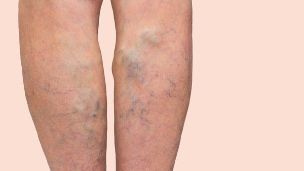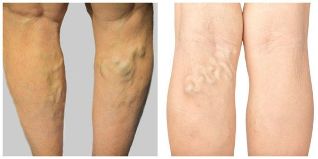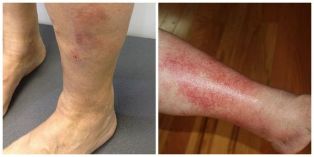Varicose veins or varices of the lower limbs primary varicose Transformation of superficial veins of the lower extremities, in which there are "bumps" or "knots" in the legs.

The warikosnaja the disease is very widely used around the world. The frequency reached 60 % among the whole adult population, depending on the country. It is interesting to note that the inhabitants of the African continent and the Asia-Pacific-suffering Region varicose veins is much less common, than the inhabitants of the European countries and the USA.
In the absence of clear causes of the varicose veins of the lower extremities met, talk about your risk factors, i.e., that the probability of the development of this pathology (property or characteristic of the human organism, any impact on the body). Generally recognised risk factors for the disease, consider age, female gender, obesity and heredity. Typical "portrait" of a patient with signs and symptoms for varicose veins — the woman in a state of Menopause with obesity, Body Mass index, multiple pregnancies and births in the medical history.
Symptoms of varicose veins on the legs
In the majority of cases, disease is varicose veins are able to recognize, without any special medical training. A clear objective signs of pathology — the emergence of the "cone" or "node" in the lower extremities, where the skin over them is, in General, do not differ in any special color. The blue veins are generally not a disease in its real sense, although they often bring the patients (mostly women), certain inconveniences aesthetic in nature.
However, is can nodules in advanced cases of varicose veins by the change in color of the skin due to venous eczema, which, through a variety of itchy skin rashes (vesicles) and redness.
These characteristics, together with swelling of the legs, which does not disappear during the night, witnesses of the formation of chronic venous insufficiency.
With regard to the subjective symptoms of varicose veins, then you do not follow the specific. Complaints can be clues to the disease, and a Symptom of an overload of the venous system of the lower extremities. Patients are most commonly concerned about the seriousness, the feeling of bloating and non-localized easily, aching pain in the calves. Sometimes there are complaints of pain in the area of the varicose veins and tiredness in the legs.
Burning, tingling, muscle cramps in the night, or Restless-Legs syndrome (unpleasant sensations in the legs at rest, if you enjoy your exercise, in order to alleviate these complaints) more common in neurological diseases, such as radicular syndromes, and should be considered with caution.
The pathogenesis of varicose veins on the legs
The pathogenesis of varicose veins of the lower extremities is rather complicated and multi-layered. An important role in the Mechanisms of the development of the disease damage to the walls and valves of the veins plays. As a result of their wrong work back flow of the blood formed (back flow), then the defeat of the endothelium (the inner lining of the blood vessel) comes, which is due to inflammation.
Later in the disease process involved the middle and inner layers of the vein wall occurs proliferation of the connective tissue in the muscular layer of Vienna, and then to atrophy and which leads to a gradual destruction of the frame of the ship. These phenomena interfere with the elastic properties of the vein, to encourage the further expansion of their lumen and spiral rotate in the length. At the same time similar changes occur in the venous valves.
It is necessary to notice that the visible venous "bumps" and "node" are varicose veins is usually due to the presence of an invisible source of great saphenous vein. In the cases of most of a large, rare small subcutaneous Vienna is a. Vysheoboznachennyh changes in the catchment area of these veins and lead to varicose veins disease.
Complications of varicose veins on the legs
Should the complications of varicose veins as a trophic disorders (trophic ulcers), thrombosis, varicose veins, altered veins (Thrombophlebitis) or bleeding from varicose veins "cone" and "node".
Trophic disorders are the result of the progression of the disease in the absence of treatment, it is often the years and decades over. You begin with skin manifestations of Hyper — pigmentation (brown spots), venous eczema and lipodermatosclerosis effectively been (hardening of the skin).
The primary localization of these changes — Shin, although the venous eczema can occur in any area of varicose veins, including on the hip. Depending on the source of varicose veins (great or small saphenous veins) trophic disturbances will be localized either on the inner or on the outer surface of the lower third of the lower leg or The result of eating disorders soft tissues is the formation of venous ulcer at the site of the previous changes. Ulcers are single or multiple, with irregular contours, sloping edges and a flat, smooth bottom. Celebrated with scanty discharge, often purulent character. The emergence of ulcers accompanied by itching and pain. For leg ulcers noteworthy is the long existence (months) and the frequent occur again.

Thrombophlebitis or thrombosis of the superficial veins is not to be confused with deep vein thrombosis. In the second case, the Situation is much more serious. But even if thrombotic defeat symptoms of varicose veins is very uncomfortable. In the area of thrombotic Vienna is a painful thread-shaped seal, for it is characteristic redness, local temperature increase, and increased sensitivity forms, and sometimes the seal limits the movement of the limb. The clinical picture is more reminiscent of an abscess or abscess.
Thrombophlebitis can be particularly dangerous when the ascending and going with a System depth. In this case, may develop such as pulmonary embolism and deep vein thrombosis.
Bleeding from varicose veins look very intimidating, because due to the high venous pressure of the blood current is strong enough. In some cases, it can also significant blood loss.
Diagnosis of varicose veins on the legs
Diagnosis of varicose veins of the lower extremities usually caused no special difficulties. The Central feature of the disease is the presence of venous "cone" and/or "node". Although, to see if excessive development of the subcutaneous fatty tissue of the lower extremities it is difficult.
To further confirm the diagnosis, different techniques of instrumental diagnosis, of which a leading Duplex ultrasound (USD) are using. Here you can varicose veins quickly, accurately and safely determine the source, assess the dimensions and the structure of the vessel, a function of venous flaps, canopy open dissemination of the flow of blood and indicate the presence of blood clots. At the same time be viewed, and deep and superficial venous System. The investigation should occur in the stand or when the patient's condition does not allow, seats lowered to the bottom. Research in the supine position can lead to in the Definition of reflux of blood clots and.
For the further assessment of the function of the heart valves and the extent of the return flow of blood used:
- Clamping ring-experiment with printing on different segments of the lower extremities;
- Attempt the with straining (Valsalva test);
- Imitation to the foot;
- Reception of Paraná — easy to attempt the rearing of a patient from the state of equilibrium with the aim of the call to the tension of the calf muscles.
Summary of ultrasound Duplex investigation of the veins of the lower extremities is necessary, in the Form of the decision, and a graph drawing "venous" show. The results of the study provide valuable assistance in the planning of further treatment. However, you need to take into account only in connection with clinical data, as changes in ultrasound image, if no objective signs of the disease (varicose veins) should be considered functional (i.e., not in connection with the pathology of the veins). It is also worth noting that the ultrasound examination be performed if the diagnosis is clear and if the Patient is not planning the operative treatment of varicose veins.
There are other methods of diagnostics:
- Doppler ultrasound - Doppler ultrasound (not to be confused with USDS);
- plethysmography;
- x-ray density of venography;
- Radio-telegraphy;
- Computed tomography (CT);
- Magnetic resonance imaging (MRI);
- Thermography;
- intravascular ultrasound examination (vsuzi) — a new method.

The treatment of varicose veins on the legs
The primary goal in the treatment of varicose veins of the lower extremities, the elimination of all false the veins. This is only possible with the invasive procedure. There are three possibilities:
- Delete — combined Phlebotomy, short, stripping, mini phlebectomy, dissection of perforating veins;
- "Bonding" — sclerotherapy, mechano-chemical sclerotherapy, cyanoacrylate fuming desertification;
- "The brewing process" — endovenous Laser or radio-frequency Obliteration.
To achieve the therapy goals necessary for two tasks to perform: the cause of varicose veins (so-called vertical back flow) remove and varicose veins. For a long time the most commonly used method is the combined Phlebotomy was. Your technical execution is done in two steps:
- Ligation anastomosis — the connection of the saphenous vein with the common femoral artery (ligation);
- Delete the trunk of the Vena saphena Magna with a probe (stripping).
This intervention differs raditude and has a number of disadvantages, in an Operation of frequent necessity in anesthesia is possible, the presence of cuts and seams, a tangible rehabilitation time and increased, in comparison to other methods, the risk of complications.
But about twenty years ago, phlebology Revolution occurred"". It was possible thanks to the global introduction of the ultrasound examination and the appearance of the graceful technique endovenous thermal obliteration. Your beings back consists of a in the influence of high temperature on the vein wall from the inside. This is done by means of laser radiation (EVLO) or RF exposure (RFMOs), "saarialho" the Lumen of the vein.
To work in Vienna immediately ceases, and then is gradually absorbed. This method makes it possible, without cuts, fast, effective, safe, and aesthetically pleasing vertical fix back flow without further Rehabilitation. As a prominent representative of the "office surgery", endovenous thermal Obliteration for the past ten years is considered to be the best method for the treatment of varicose veins in the world.
Sclerotherapy (bonding of the affected veins through the introduction to your special fabrics) is also widely used in the treatment of varicose veins. But to achieve the desired result requires a careful selection of the patients because of the increased risk of recurrence of the disease.
Conservative treatment, including compressive therapy, flebotropnyje drugs and local dosage forms (gels, ointments), have only auxiliary activity, affected mainly the symptoms of varicose veins, not through the elimination of the source.
Forecast. Prevention
Taking into account the modern methods of treatment, the prognosis for varicose veins effective. Even with the seemingly more advanced cases, the elimination of varicose transformed veins leads to a rapid improvement in the condition of the patient.
However, when planning the treatment is very important, an assessment of its risks, because each Intervention is still in the possible side effects. A direct task of the doctor — as much as possible, its probability is decreased with the. Prior to any Manipulation must be with the patient all aspects of the discussion about the Intervention and get his signature on informed consent.
All of the undesirable phenomena can be divided into risks associated with the surgery, including the anesthesia and the risks on the part of the patient.
Risks of surgery can be small, for example, inflammation (inflammation of a vein) in the "brewed" or sklerozirovannyh veins, accompanied by a seal, which in their projection and moderate pain syndrome. Can occur in areas of skin with reduced sensitivity and Hyper pigmentation of the skin. All of these symptoms are temporary and usually go fast enough without any consequences.
Grand complications include deep vein thrombosis, allergic and toxic reactions to drugs, anesthetics. They are extremely rare, however, for the individual patient, in which similar happens complication of the case, is a 100%, even if the statistics in 1 to 10000 operations.

Prevention of venous thrombosis, mainly based on the calculation of the risk according to the so-called scale-points-System with the help of the table Caprini. It contains a variety of risk factors, their gradation. The consideration of the individual factors and the rearing of accumulated points determines the degree of risk and, thus, its prevention. The most important means for the prevention of venous thromboembolic complications are the following:
- Minimizing the morbidity of the Operation;
- early activation of the patient;
- Compression stockings;
- pharmacological prevention, i.e., the mapping of the indications of anticoagulant medications, blood thinners.
And with regard to the prevention of varicose veins, it simply does not exist, because so far it is not clear the main reason for the pathology, about the impact and prevent the emergence of diseases. With this context, and pretty frequent recurrence of varicose veins after any type of Intervention. But, given all the advantages of the use of the minimally-invasive treatment, it is not significant that is not a Problem. The feet keep the order simple, the main thing in time to which the phlebologist

























